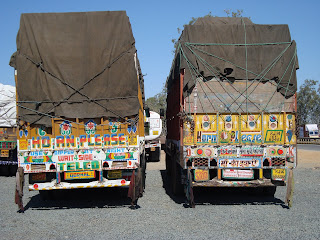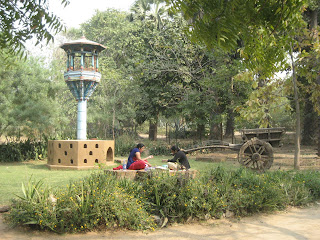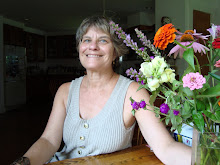



We're just about to end a two-day trip to
Ahmedabad, one of the two big cities nearest to
Anand (the other is
Vadodara, which is the city we flew into). We came up on Thursday morning, leaving at about 10 a.m., and arriving shortly before noon, and the same car and driver from IRMA that brought us here should be arriving in about 15 minutes -- at 7 p.m., today being Friday -- to take us "home." A lot has been packed into these two days; I'll try to hit the high points.
The drive up was easy and very pleasant -- a road that we're told is one of the best highways in all of India (actually two lanes in each direction, which is highly unusual, and also with limited exits and entrances, ditto), and very little traffic. Once we got beyond the sprawl at the edges of
Anand (which isn't that bad, since
Anand is quite a small city), the countryside was lovely -- flat, but almost all cultivated with extremely neatly tended fields of crops, tidy
looking houses and outbuildings (at least they looked tidy from the highway), and big haystacks; goats and cows wandering around; trees and flowers; and -- quite notably -- no roads -- it was obvious that these were farms and villages that people only walked between. One drove quite a way between seeing any roads at all, which only added to the serene and scenic quality. After the almost overly-tended campus of IRMA, and the chaotic noisy traffic and blare of "downtown"
Anand, it was quite a pleasure to see the fields unrolling outside the car windows as people went about their rural business (of course, seeing it through car windows is probably far more pleasurable than actually having to do the work, but that's another issue. . . .). But then -- bang! -- we entered the outskirts of
Ahmedabad, and oh my God! it made
Anand seem like a tranquil paradise. The road, once we got off the highway, was terrible (dirt, bumps, occasional asphalt), the traffic was incredible, and on both sides of the narrow road it seemed like the place was in the midst of some gigantic upheaval of destruction and re-construction: huge ditches being dug on one side of the road with mounds of earth thrown up nearby, houses literally sliced in half in the process of being torn down, with interior spaces and furniture thrown open to the passing eye, animals wandering around, stalls stuck into nooks and crannies selling all kinds of stuff, and here and there, in the midst of this chaos, an occasional new, modern building, perhaps a foretaste of what was to come, perhaps an effort at development abandoned to the sprawl. As we actually got closer to the city center, things started to smooth out a bit -- the streets were consistently paved and regular, the buildings lined up on either side in a more predictable fashion, the animals gradually thinned out and disappeared -- but the noise, the traffic, the dust, the general overabundance of people and places everywhere you turned your eyes, persisted. We snaked our way through traffic on some major busy streets and finally turned down a narrow alley at the end of which was the hotel -- Hotel Volga -- recommended by Lonely Planet at which we had made our reservation. We had deliberately chosen a mid-price rather than a western-style "regular" hotel, and although it wouldn't be the choice of those who like to stay at the Ritz-Carleton, or maybe even the Holiday Inn, it was actually totally clean, the lobby and room were both spacious and perfectly decently decorated, and the bathroom -- always an important feature -- had a terrific shower and completely functional, if not particularly modern, toilet and sink. For $24, it was a good deal in our estimation. For those who might be a little less flexible in their standards than we are, a photo is attached so you can judge for yourself.
After checking in, we decided to head across the river (the city is divided in half by the
Sabarmati River, with the "old" city on the east side and the newer metropolis on the west -- our hotel was quite near one of the bridges on the eastern side) to a bookstore-coffee shop touted by Lonely Planet. Bob was almost salivating at his first chance to be in a decent coffee shop since we had arrived in India. Since the distance didn't seem very far (we had a map), we walked across the bridge and then, because we were hungry by that time, stopped at a place we picked at random for lunch, which turned out to have excellent Indian food. After getting lost and retracing our steps several times, we finally made our way to the bookstore/cafe, which was underneath a pretty sketchy-looking small shopping mall, but did, indeed, have a western-style coffee shop (again, we're not talking upscale here -- marble
countertops and the like -- but a pleasant place with tables and chairs, a range of hot and iced coffees, tea, and snacks -- even
cappucccino, which was what Bob went for. He said it was the worst
cappuccino he'd ever had, and he would have been better off just ordering regular coffee, but hey -- it was at least a shadow of what he wanted). I had a coffee and ice cream shake, which was delicious. The bookstore itself was gigantic and the most "western" place I've been in so far -- 80% of the books were in English, so it obviously serves the English-speaking population, such as it may be, in
Ahmedabad, and there was everything: fiction, non-fiction, children's books, DVDS, stationery, history, self-help, etc. etc. -- a regular Borders (o.k., maybe not quite as big or fancy as Borders, but pretty close). This made it fairly uninteresting to me, however, so although I looked around while Bob read his newspaper over his
cappuccino, there wasn't much to capture me. I did, however, get a children's book for learning to write the Hindi alphabet and simple words, since I think the Hindi writing is very beautiful and I have the idea that I will learn (we'll see . . . .).
Despite the somewhat shabby exterior of the shopping center, it turned out there was quite an upscale clothing store in it as well, which Lonely Planet described, quite accurately, as looking like it had lost its way on the road to NYC, so we checked that out as well. That was even more upscale than the bookstore. The women's clothing (Indian style saris and
shalwar kameezes) was, indeed, extremely beautiful, but the prices were actually -- while not NYC level -- high compared to anything we had seen anywhere (e.g., $60 for the long top and matching pants that make up the standard alternative to a sari), so I decided to hold off for a bit. I may go back!
By then it was late afternoon and we were beginning to flag, but we pressed on to a crafts market that Lonely Planet said had lovely things, taking an auto-rickshaw to get there. The crafts market was in stalls around the perimeter of a park, and it did have beautiful fabrics, scarves, wall hangings, etc., but again -- this being our first exploration of what's out there to buy -- we decided just to scope stuff out and save the actual buying for another time (we will be here for almost 4 months, after all). We were just too tired to be able to handle choosing the right things from the absurd profusion of beautiful things that existed in stall after stall after stall, let alone bargain properly for their price. Although we enjoyed seeing the stuff, when we entered the park afterward for a walk at twilight, it was actually a relief just to look at trees and greenery. It was a lovely, big park, well-planted and tended, and well used by couples, families with children, old people, all of whom were striding (the young exercisers) or strolling (the old folks) around the circling paths.
We got another auto-rickshaw to take us back to our hotel, and the driver told us that because of the holiday parade taking place on the main street near the hotel (which we knew about -- the hotel manager told us it was happening from 2 p.m. until 10 p.m., and we had actually been eager to get back to see it, since we left the area before it started), the bridge would be closed and he couldn't get us there. No problem; we said he could drop us off on the western side of the bridge and we would walk across and go the three blocks or so from there to our hotel on foot. The holiday is
Muharram, a Muslim holiday that commemorates the defeat of Mohammed's son-in-law in some long-ago battle -- and although we think of India as Hindu rather than Muslim, it's celebrated big-time in
Ahmedabad, whether just by the Muslims who live here (many) or by Muslims and Hindus alike, I have no idea. Walking back across the bridge, now closed to traffic, was fun, sort of like when they close Memorial Drive in Cambridge -- everyone out in the street, obviously in a holiday mood, no cars to get between you and river, lights that are strung along the bridge twinkling in the evening dark.
But as we got to the end of the bridge, the crowd started thickening, and the music from the procession (the manager of our hotel, who spoke pretty good English, for some reason rejected "parade" as a word to describe it when we used it, and said it was a "procession") got louder and louder, which was pretty loud considering it was drums rhythmically banging -- bang! bang! bang! -- and Indian music blaring over a loudspeaker. People were crowded onto the ramparts of the bridge from which you could just get a view of the procession a few streets down, and as we stepped off the bridge, there was a profusion of carts selling street food of many sorts, and entire families sitting on the ground having picnics in the dark. The crowd kept getting thicker and thicker as we got nearer to the main street off which the alley to our hotel ran, which was the same street on which the procession was passing. By the time we got there, it was a throbbing mass of people, luckily liberally sprinkled with enough women and children that it didn't seem threatening, but also plenty of young men in groups, definitely making it quite difficult to thread your way through. By the time we were almost at the street where the procession was passing, the crowd was so dense there were moments when it carried you along almost despite yourself, and while I was actually somewhat
exhilarated by the whole thing, Bob was -- perhaps more
reasonably -- getting uncomfortable, and insisted I put away my camera, with which I was trying to take pictures, hold his hand, and get out of there. Reluctantly, I complied. although I really wanted to get photos of the procession itself, which was an apparently endless stream of people bearing large elaborate silver or tin models of temples or mosques on their shoulders. Even in the relatively short period of time we were out there, we must have seen more than a dozen of these go by, and plenty more seemed to be coming. Although I kept my camera in my bag while we pushed and shoved our way through the crowd (we're talking the worst possible rush hour on the NYC subway here), when at last we somehow emerged, in one piece, into the relatively calm breathing space of the alley in which our hotel was situated, I was able to take a few photos, which give you an idea 0f what I'm talking about. Meanwhile, don't forget that the music is going like crazy the whole time. This is somewhat of a trance state I'm describing. By the time we got up to our room, Bob was completely spent and I was all jazzed up -- not a very compatible combination. Although it was after 8, we hadn't yet eaten supper, which we had been planning to have at a very highly recommended restaurant on the top floor of an upscale heritage hotel that was right around the corner from our hotel. But there was no way that Bob was going back out into that crowd in the street again, so we just sat in silence, each in our quite different mood. Finally, however, as the hour approached 9:30, we both began to relax, and the noise from the street seemed to be dying down, and we were hungry enough that we decided we could at least go back out into the alley and see how things were. As it turned out, although the procession wasn't completely over, the crowd had thinned out a fair amount, and we decided we could make it to the restaurant, which we did. The hotel itself has been created by the conversion of a gorgeous old early 2oth century (late 19th century?) mansion that belonged to a huge upper crust extended Indian family; there were striking large photographs of them in groups and individually hanging in the halls. The place was both faded and grand: muted mustard and red colored walls, old furniture and decor in the lobby, slightly shabby even, but clearly a magnificent thing, with stairways rising up in various directions through a huge interior courtyard to the balconies of rooms, almost like being inside an intricate Escher drawing. The restaurant under a canopy on the roof served a prix fixe dinner of a dazzling number of courses of different vegetarian dishes, mixed with sweets of various mysterious kinds -- a fire in a brazier on the floor in the middle of the room sent off small sparks of light and a bit of warmth (unnecessary, since the temperature was lovely), so it was dim but not dark -- quiet and far removed from the madness of the street. The very final dish was a fruit plate with two leaves neatly folded into packets to hold the anise seed mix that Indians use after eating to "refresh" their mouths -- I hope the photo conveys the charm of the entire meal. We ate well, unwound, enjoyed -- an excellent ending for a busy day. Then we walked back to our hotel to sleep, and that was our first day in the Big City. To be continued. . . .

































